
FPV (First-Person View) drone flying offers an experience unlike any other. Imagine strapping on a pair of goggles and suddenly seeing the world from a bird’s eye view as you soar through the air with complete freedom. It’s exhilarating, challenging, and deeply rewarding. However, getting started in this hobby can seem overwhelming with its technical terminology, various equipment options, and learning curve.
This comprehensive guide will walk you through everything you need to know to get started in the FPV drone hobby in 2025. From understanding what FPV is to choosing your first drone, mastering flying skills, and joining the community, we’ve got you covered.
Table of Contents
What is FPV Drone Flying?

FPV drone flying involves piloting a drone while viewing the live video feed from a camera mounted on the aircraft. Unlike traditional drones where you watch the aircraft from the ground, FPV puts you in the “cockpit,” providing an immersive flying experience.
The FPV experience is made possible through a combination of:
- A camera mounted on the drone
- A video transmitter that sends the camera feed
- A receiver on your end (goggles or monitor)
- A radio controller to pilot the drone
This setup creates what many pilots describe as the closest feeling to actually flying without leaving the ground. The direct visual connection makes precision flying, freestyle tricks, racing, and cinematic footage capture possible in ways that traditional drone flying can’t match.
Why Choose FPV Over Traditional Drones?
Traditional consumer drones like those from DJI provide excellent stability and ease of use. They’re great for aerial photography and video, but they don’t offer the same visceral flying experience as FPV. Here’s why many enthusiasts choose FPV:
- Complete control: FPV drones typically fly in “manual mode,” giving pilots full control over every aspect of flight.
- Speed and agility: Without electronic stabilization, FPV drones can perform maneuvers that would be impossible with standard consumer drones.
- Community: The FPV world has a vibrant, supportive community of pilots and builders.
- Customization: Most FPV enthusiasts build or modify their drones, allowing for complete personalization.
- Cost-effectiveness: While the initial investment may be similar, repairing and upgrading FPV drones is often cheaper in the long run.
The Different Types of FPV Drones
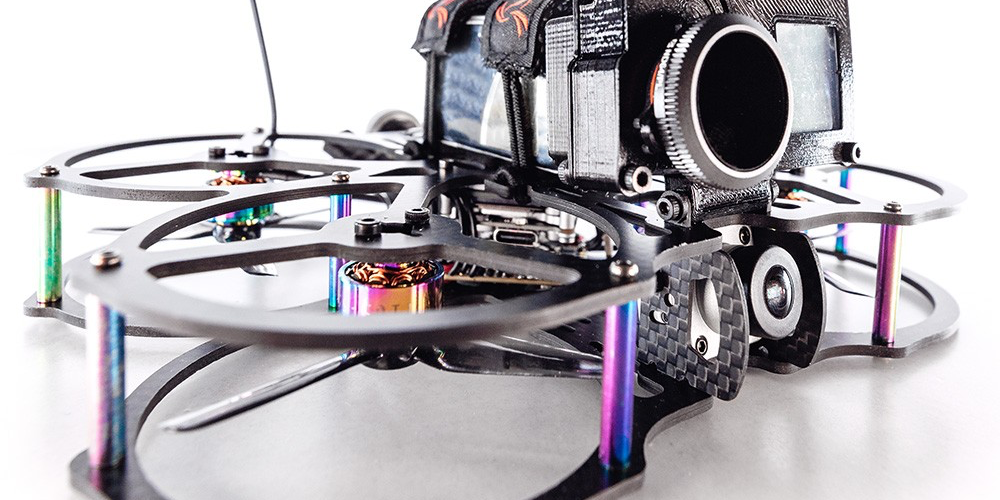
Before diving into equipment selection, it’s important to understand the main types of FPV drones available:
Tiny Whoops and Indoor Micro Drones
- Frame size: Under 100mm
- Props: 1-2 inch
- Weight: Under 250g (often under 50g)
- Perfect for: Beginners, indoor flying, learning fundamentals
- Pros: Affordable, durable, safe to crash, no registration required in most countries
Cinewhoops
- Frame size: 3-inch class (140-180mm)
- Props: 3-inch ducted propellers
- Weight: 250-350g
- Perfect for: Indoor/outdoor flying, cinematic footage
- Pros: Stable, safe around people, good camera options
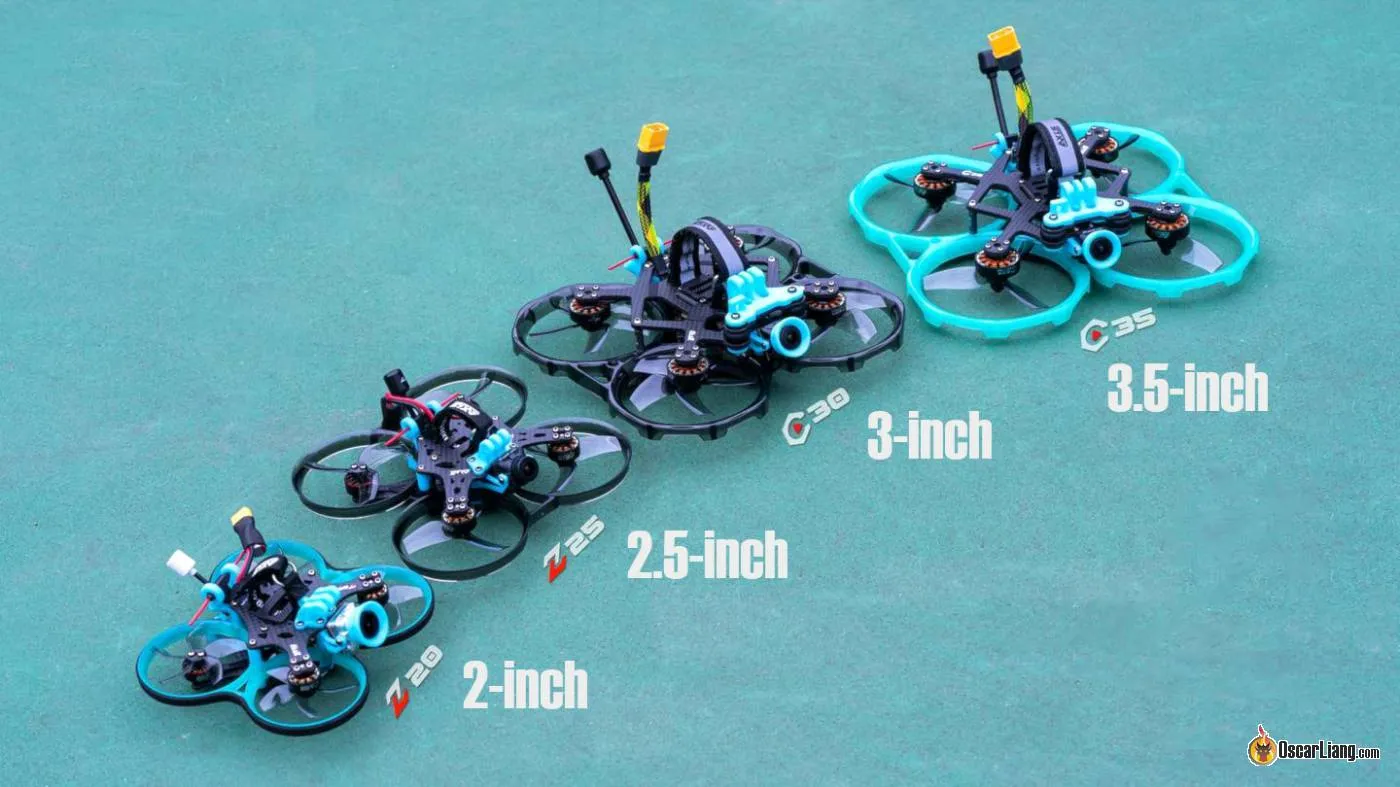
Freestyle/Racing Drones
- Frame size: 5-inch class (200-220mm)
- Props: 5-inch
- Weight: 350-700g
- Perfect for: Outdoor freestyle tricks, racing, general flying
- Pros: Best power-to-weight ratio, most popular size with greatest parts availability
Long-Range/Cinematic Drones
- Frame size: 6-7 inch class (250-500mm)
- Props: 6-7 inch
- Weight: 700g+
- Perfect for: Extended flight times, carrying better cameras, long-distance flying
- Pros: Longer flight times, smoother footage, payload capacity
X-Class (Large Format)
- Frame size: 800mm+
- Props: 9-13 inch
- Weight: Often over 1kg
- Perfect for: Extreme speed, specialized racing
- Pros: Ultimate performance, unique flying experience
Getting Started: The Essential FPV Equipment

Starting in FPV requires several components, each playing a crucial role in your flying experience. Let’s break down what you’ll need:
1. The Drone
For beginners, there are two main approaches:
Ready-to-Fly (RTF) Kits: These complete packages include everything you need to start flying immediately. They’re perfect for beginners who want to focus on learning to fly before diving into the technical aspects.
Popular RTF options for 2025 include:
- BetaFPV Cetus X Kit (ideal for absolute beginners)
- EMAX Tinyhawk 3 RTF Kit (versatile indoor/outdoor option)
- DJI Avata 2 (high-end option with excellent digital video)
Building Your Own: While more challenging, building your own FPV drone provides valuable knowledge about how the components work together. This approach also makes repairs easier since you’ll understand the entire system.
For a first build, consider:
- A 5-inch freestyle frame like the TBS Source One
- Flight controller/ESC combo (simplifies wiring)
- 1600-1800KV motors for 4S batteries
- Reliable FPV camera and video transmitter
2. Radio Transmitter (Controller)
Your radio controller is your primary interface with the drone and a long-term investment that will work with multiple aircraft. Quality options for 2025 include:
- RadioMaster Zorro ELRS: Compact size, great value
- Radiomaster TX16S: Full-size controller with extensive customization
- TBS Tango 2: Compact, high-quality controller
- DJI RC Motion 2: If using the DJI ecosystem
Key features to look for:
- Multi-protocol support or ELRS (ExpressLRS) compatibility
- Hall-effect gimbals for precision
- Model memory for multiple drones
- USB connectivity for simulator practice
3. FPV Goggles or Monitor

Your viewing device is critical for the FPV experience. Options include:
FPV Goggles:
- Entry-level: Eachine EV800D (budget-friendly analog)
- Mid-range: Fat Shark Attitude V6 (reliable analog option)
- High-end: DJI Goggles 2 (premium digital system)
FPV Monitors:
- Monitors provide a less immersive but more social experience
- Good for beginners who might get disoriented in goggles
- Allow others to watch your flight
4. Batteries and Charger
Proper battery selection and care are essential for safety and performance:
- Battery Types: Most FPV drones use LiPo (Lithium Polymer) batteries
- Cell Count: Ranges from 1S (one cell) for tiny whoops to 6S for high-performance quads
- Capacity: Measured in mAh (milliamp hours), typically 450-650mAh for micro drones and 1300-1800mAh for 5-inch quads
- C-Rating: Indicates discharge capability; higher is better for performance
For chargers, invest in:
- A balance charger with storage function
- Parallel charging board (for charging multiple batteries)
- Fireproof LiPo bag for safe storage and charging
The Simulator: Your First Flying Experience
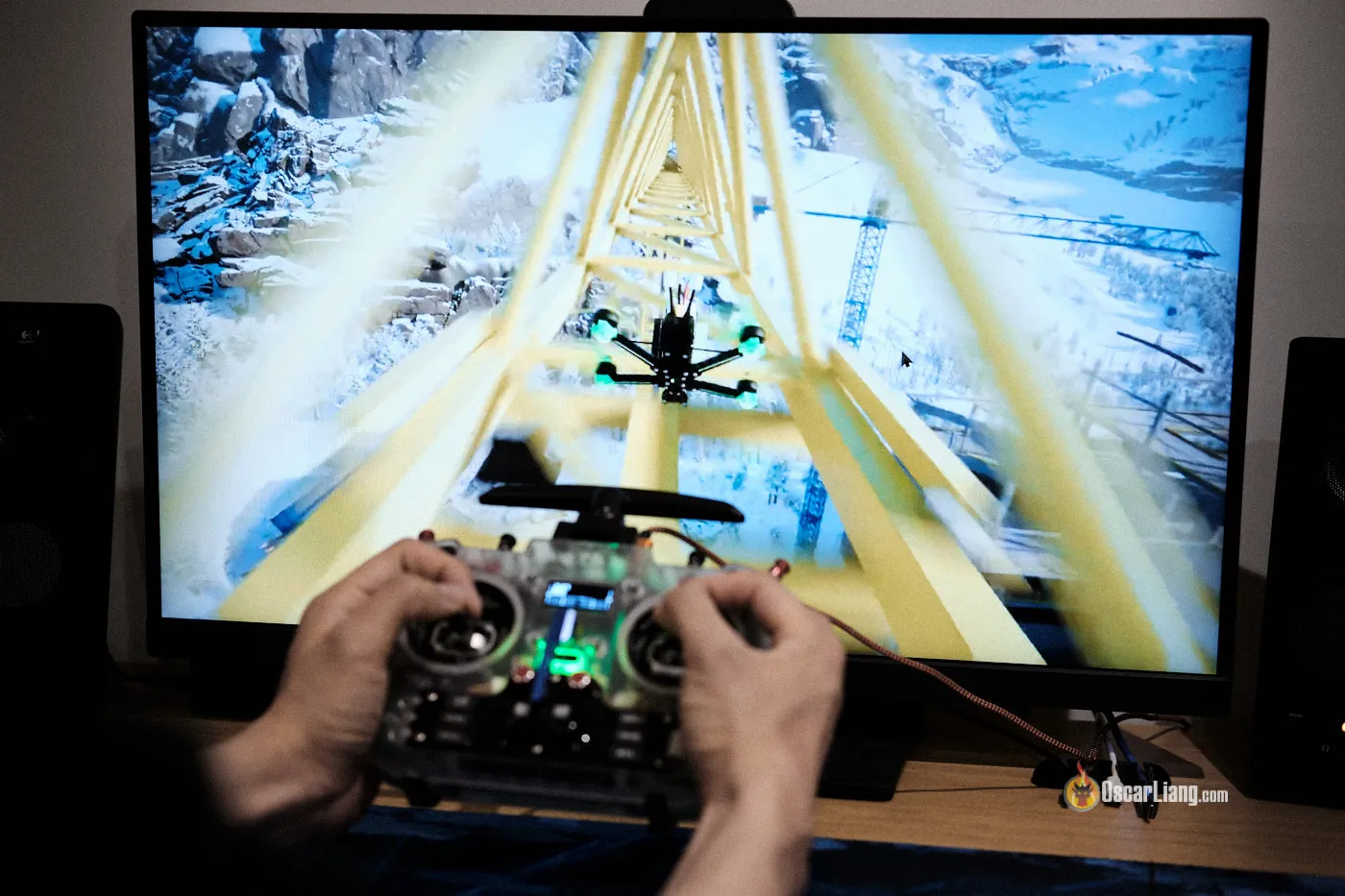
Before risking your physical drone, spend time in an FPV simulator. This approach has several benefits:
- Learn fundamentals without crash-related costs
- Practice in any weather, any time
- Try different drone configurations
- Build muscle memory for stick control
Top FPV simulators for 2025 include:
- Velocidrone: Widely regarded as having the most realistic physics
- Liftoff: Great graphics and multiplayer options
- TRYP FPV: Excellent for freestyle practice
- DRL Simulator: Racing-focused with structured progression
Most modern controllers connect to PCs via USB, allowing you to use your actual transmitter with the simulator for realistic practice. Aim for at least 10-20 hours of simulator time before your first real flight.
Learning to Fly: Building Your Skills
FPV flying has a steep learning curve, but with methodical practice, you’ll make steady progress. Here’s a structured approach to building your skills:
Stage 1: Master the Basics (Simulator + Tiny Whoop)
- Takeoff and landing
- Hovering in place
- Basic forward flight
- Gentle turns using coordinated roll and yaw
- Throttle control for maintaining altitude
Stage 2: Developing Control (Simulator + Micro Drone)
- Figure-8 patterns
- Proximity flying around obstacles
- Smooth speed changes
- Banking turns at different angles
- Recovery from unusual attitudes
Stage 3: Advanced Flying (Larger Drones)
- Power loops
- Split-S turns
- Rolls and flips
- Diving and power management
- Flow-style flying combining multiple maneuvers
Key practice tips:
- Focus on one skill at a time
- Record your flights for review
- Set specific, achievable goals for each session
- Practice regularly rather than infrequently in long sessions
- Join group flying sessions to learn from others
FPV Drone Regulations: Flying Legally and Safely
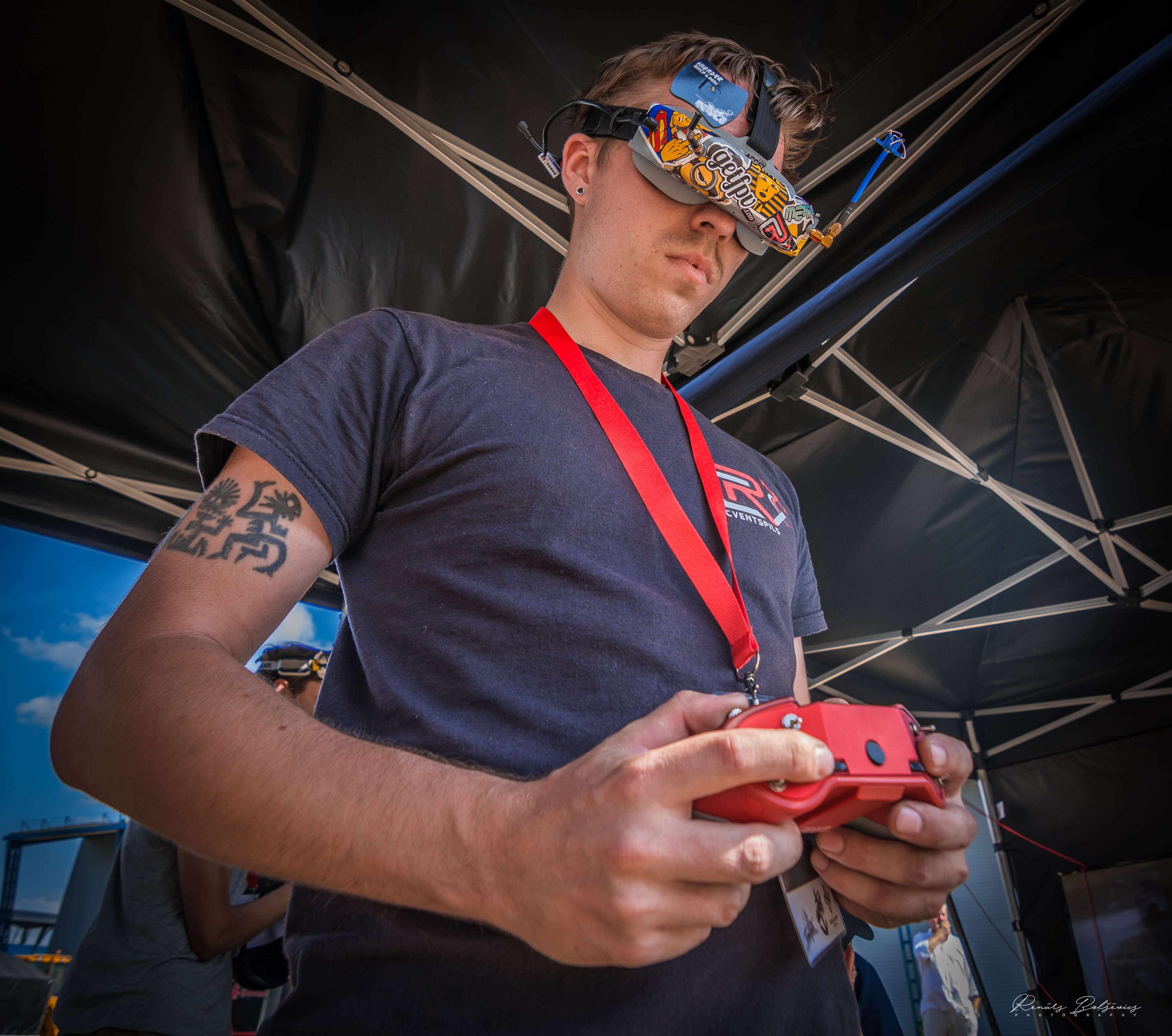
Understanding drone regulations is crucial for responsible flying. While rules vary by country, here are the key considerations for US flyers in 2025:
Registration Requirements
- Drones over 250g (0.55 lbs) must be registered with the FAA
- Each drone needs a registration number visibly displayed
- Remote ID requirements apply to most FPV drones as of 2023
Airspace Restrictions
- Maximum altitude of 400 feet AGL (Above Ground Level)
- No flying in restricted airspace without authorization
- Avoid airports, heliports, and temporary flight restrictions
Operating Rules
- Maintain visual line of sight (may require a spotter when using FPV goggles)
- No flying over people or moving vehicles
- No flying from moving vehicles
- Daylight operations only (unless drone has appropriate lighting)
FPV-Specific Considerations
- FPV flying technically requires a visual observer maintaining visual line of sight
- Some FPV video transmitters require an amateur radio license to operate legally
- Flying as part of a recognized Community-Based Organization (CBO) provides some regulatory flexibility
Resources for staying informed:
- FAA’s B4UFLY mobile app
- AirMap or Kittyhawk apps for airspace information
- Local FPV clubs for site-specific guidelines
Building vs. Buying: Which Approach Is Right for You?

One of the first decisions you’ll face is whether to build your first FPV drone or buy a ready-to-fly model. Both approaches have merits:
Buying a Ready-to-Fly Drone: Pros
- Immediate flying experience
- Professional tuning and setup
- Warranty support
- Less technical knowledge required
- Lower initial frustration
Building Your Own Drone: Pros
- Deep understanding of components
- Easier troubleshooting and repairs
- Customization for specific needs
- Pride of flying something you built
- Cost savings in the long run
In 2025, the gap between RTF and DIY has narrowed, with excellent pre-built options available. For most beginners, a sensible approach is:
- Start with a ready-to-fly micro drone to learn flying basics
- Practice in simulators alongside real flying
- Build your first 5-inch freestyle quad after gaining experience
- Gradually upgrade or customize components as you learn
This progression minimizes risk while still providing the full FPV experience.
Cost Breakdown: Budget Planning for FPV
FPV can be as expensive or affordable as you make it. Here’s a realistic breakdown of costs in 2025:
Budget Entry (Approximately $300-500)
- RTF micro drone kit with controller and goggles: $200-300
- Extra batteries and basic accessories: $50-100
- Simulator software: $20-30
- Repair parts: $30-70
Mid-Range Setup (Approximately $800-1200)
- Quality radio transmitter: $150-220
- Analog FPV goggles: $250-350
- 5-inch freestyle drone (RTF or DIY): $250-400
- Batteries, charger, and accessories: $150-230
High-End Setup (Approximately $1500-2500)
- Premium radio controller: $200-350
- Digital FPV system with goggles: $700-1000
- High-performance custom build or premium RTF: $400-600
- Multiple batteries and advanced charging system: $200-300
- GoPro or similar action camera: $300-500
Additional costs to consider:
- Replacement parts (props, motors, frames)
- Tools for building and repair
- Travel cases for equipment
- FPV backpack for convenient transport
Cost-saving tips:
- Buy used equipment from reputable sellers
- Start with analog before investing in digital
- Learn to solder and repair your own gear
- Join local groups to try equipment before buying
Joining the FPV Community
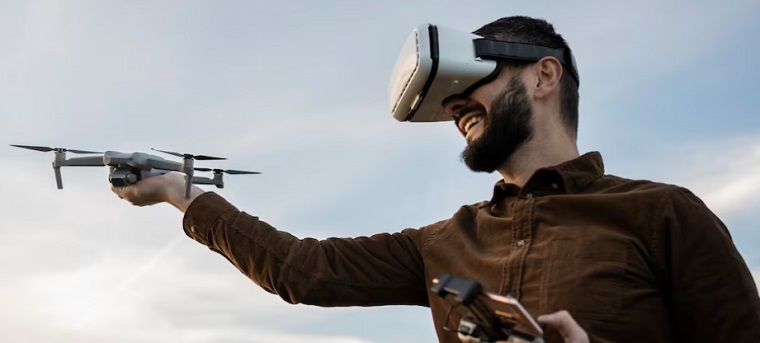
The FPV community is one of the hobby’s greatest assets. Connecting with other pilots provides support, knowledge sharing, and flying companions. Here’s how to plug in:
Online Communities
- Reddit: r/fpv, r/Multicopter, r/diydrones
- Forums: IntoFPV, FPV Drone Pilots Forum
- Discord: FPV-related servers with real-time chat
- Facebook Groups: Local flying groups and specialized interest groups
Local Connections
- MultiGP chapters for organized racing
- Academy of Model Aeronautics (AMA) fields
- Local drone meetups through Meetup.com
- Hobby shops with FPV focus
Events
- Drone racing competitions
- Freestyle jams
- Building workshops
- Demonstration days
The community provides invaluable resources for:
- Troubleshooting help
- Flying site recommendations
- Group purchase opportunities
- Mentorship for new pilots
Essential Accessories and Tools

Beyond the core components, several accessories make the FPV experience more enjoyable:
For Transport and Storage
- Hard case or backpack for goggles and radio
- LiPo-safe bags for battery transport
- Prop guards for travel protection
For Building and Repairs
- Soldering iron (temperature-controlled)
- Quality hex drivers
- Prop removal tool
- Needle-nose pliers
- Multimeter for electrical testing
- Heat shrink tubing assortment
For Field Use
- Portable workstation
- Extra propellers (many!)
- Battery voltage checker
- Small parts organizer
- Electrical tape and zip ties
- Spare hardware kit
For Extended Sessions
- Folding chair
- Battery charger power supply
- Sunshade for screen viewing
- Extra goggle batteries
FPV Drone Trends for 2025
The FPV landscape continues to evolve rapidly. Here are the key trends shaping the hobby in 2025:
Enhanced Battery Technology
- Higher energy density LiPo batteries
- Improved Li-ion options for longer flight times
- Smart battery systems with integrated telemetry
Digital FPV Systems
- More affordable HD video transmission options
- Lower latency performance rivaling analog
- Integrated recording capabilities
Component Integration
- All-in-one flight controller/ESC/receiver units
- Simplified wiring harnesses
- Plug-and-play ecosystem compatibility
AI-Assisted Flying
- Dynamic obstacle avoidance
- Return-to-home capabilities while maintaining manual control
- Automated trick sequences for learning complex maneuvers
Regulatory Adaptation
- Purpose-built Remote ID solutions for FPV
- More standardized approval processes for custom builds
- Enhanced geofencing capabilities
Common Mistakes to Avoid as a Beginner
Learning from others’ experiences can save you time, money, and frustration:
- Skipping simulator practice: The simulator is your safest and most cost-effective learning tool.
- Starting too big: Beginning with a large, powerful drone often leads to costly crashes.
- Ignoring battery safety: LiPo batteries can be dangerous if mishandled.
- Flying without a pre-flight check: Always verify your equipment before takeoff.
- Flying in inappropriate locations: Choose open spaces away from people and property.
- Not learning basic repairs: Simple fixes can get you back in the air quickly.
- Upgrading too soon: Master your current equipment before moving to more advanced gear.
- Flying alone as a beginner: Having an experienced pilot nearby provides invaluable assistance.
- Not securing your drone: Always disarm immediately after landing or crashing.
- Flying beyond visual range too early: Build confidence within visual range before attempting longer flights.
FPV Drone Flying Techniques to Practice

Developing solid flying technique requires deliberate practice. Here are key skills to focus on:
Precision Hovering
- Practice holding position at varying altitudes
- Maintain orientation awareness during stationary flight
- Control drift in windy conditions
Throttle Management
- Smooth altitude control during complex maneuvers
- Consistent power application through turns
- Energy conservation for extended flight times
Coordinated Turns
- Proper mix of roll, yaw, and pitch
- Maintaining altitude during turning
- Executing turns at different speeds and angles
Recovery Techniques
- Recognizing and correcting unusual attitudes
- Managing power during rapid descents
- Recovering from signal glitches or interference
Camera Work
- Maintaining smooth footage during movement
- Framing interesting subjects while flying
- Planning and executing cinematic movements
FAQ: Common Questions from FPV Beginners
Q: How long does it take to learn FPV flying?
A: Most pilots achieve basic competence after 20-30 hours of combined simulator and actual flying time. Mastery can take hundreds of hours of practice.
Q: Do I need a license to fly FPV drones?
A: In the US, recreational pilots don’t need a license for drones under 55lbs, but registration is required for drones over 250g. Some FPV video transmitters legally require an amateur radio license to operate.
Q: What’s the difference between analog and digital FPV?
A: Analog systems offer lower cost and latency but poorer image quality. Digital systems provide HD video quality but typically cost more and may have slightly higher latency.
Q: How long can FPV drones fly?
A: Flight times vary widely: tiny whoops typically fly 3-5 minutes, 5-inch freestyle quads 4-8 minutes, and long-range builds 10-20+ minutes depending on battery and flying style.
Q: Is it cheaper to build or buy an FPV drone?
A: Building can be more cost-effective long-term as you learn to repair and upgrade components individually, but ready-to-fly options offer better value for beginners when considering the learning curve.
Q: What’s the best FPV drone for a beginner?
A: In 2025, the BetaFPV Cetus X Kit and EMAX Tinyhawk 3 RTF remain excellent starting points, offering complete packages with controllers and viewing devices at reasonable prices.
Q: Are FPV drones difficult to fly?
A: Yes, they require practice and skill development. However, with simulator training and starting on appropriate beginner drones, most people can achieve competent flying within a few months.
Conclusion: Your FPV Journey Begins
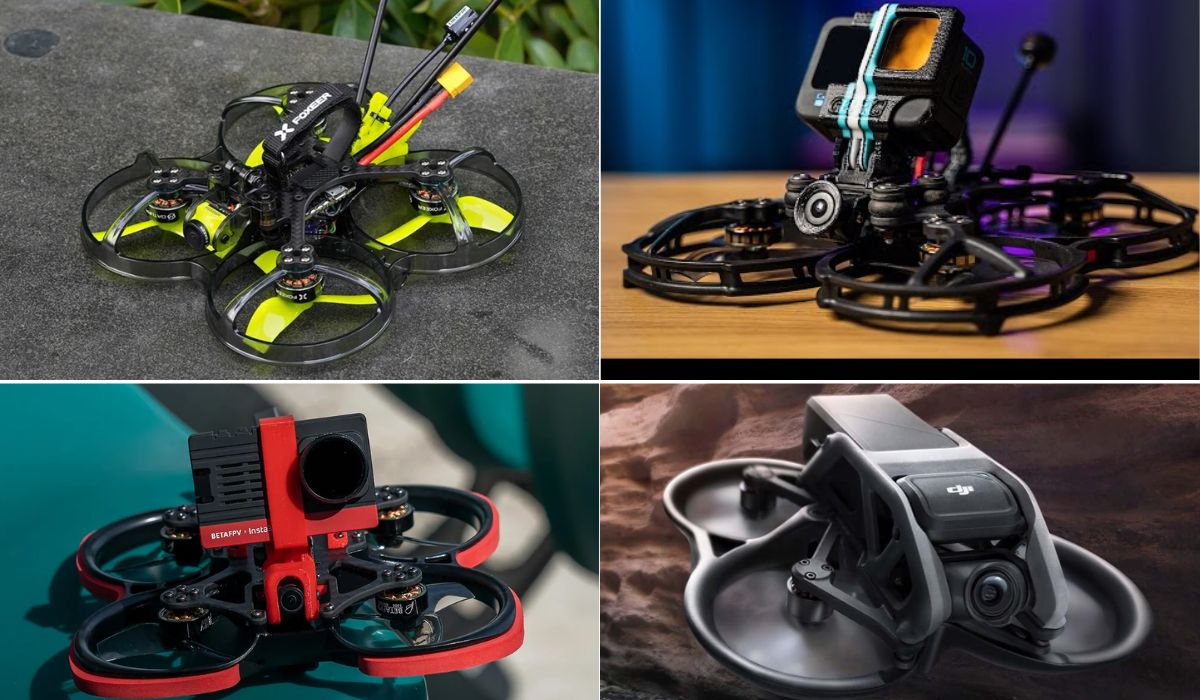
The FPV drone hobby offers a unique combination of technical challenge, skill development, and pure exhilaration. While the learning curve may seem steep, the journey is incredibly rewarding. The freedom of flight, the satisfaction of building and maintaining your own aircraft, and the supportive community make FPV one of the most engaging hobbies available today.
As you embark on your FPV adventure:
- Start small with appropriate beginner equipment
- Invest time in simulator practice
- Connect with the community for guidance
- Fly regularly to build skills progressively
- Focus on safety and responsible piloting
Remember that every expert FPV pilot started as a beginner. With patience, persistence, and the right approach, you’ll be carving through the air with confidence before you know it.
The sky awaits—happy flying!
